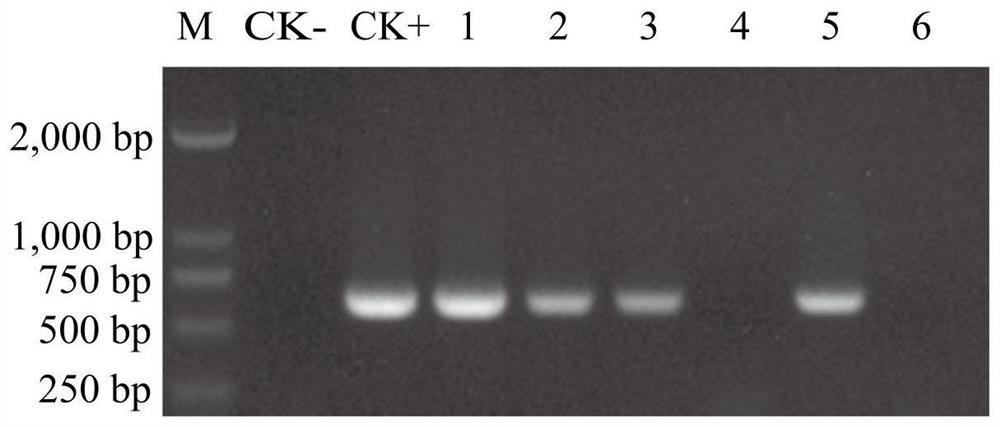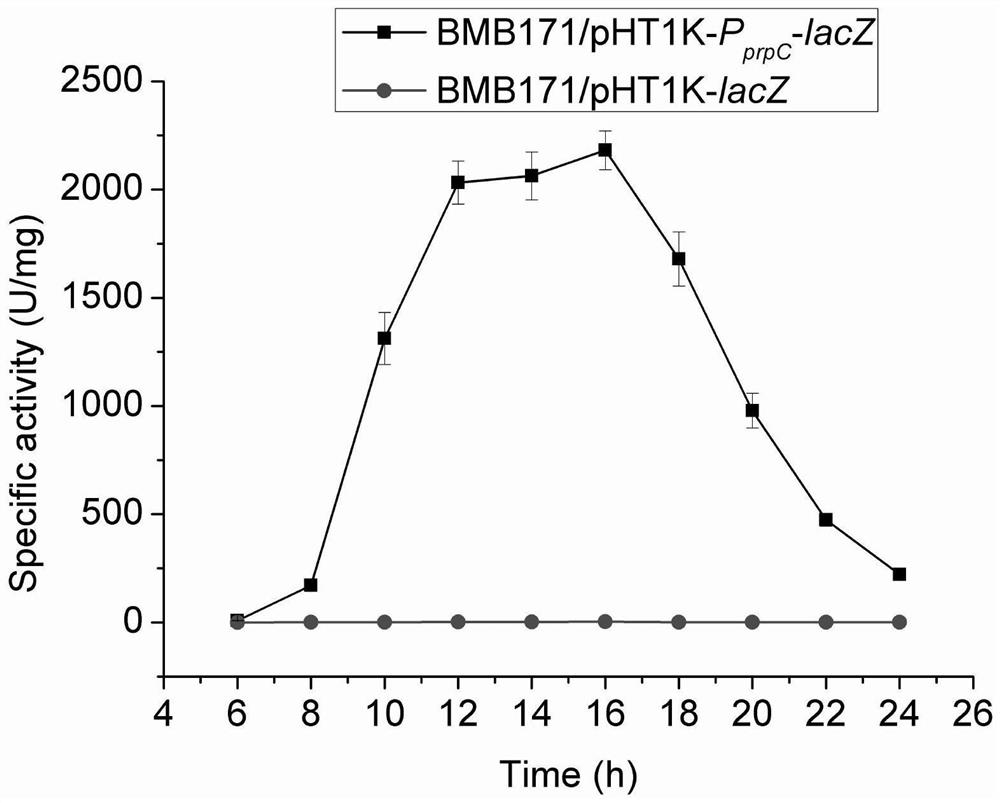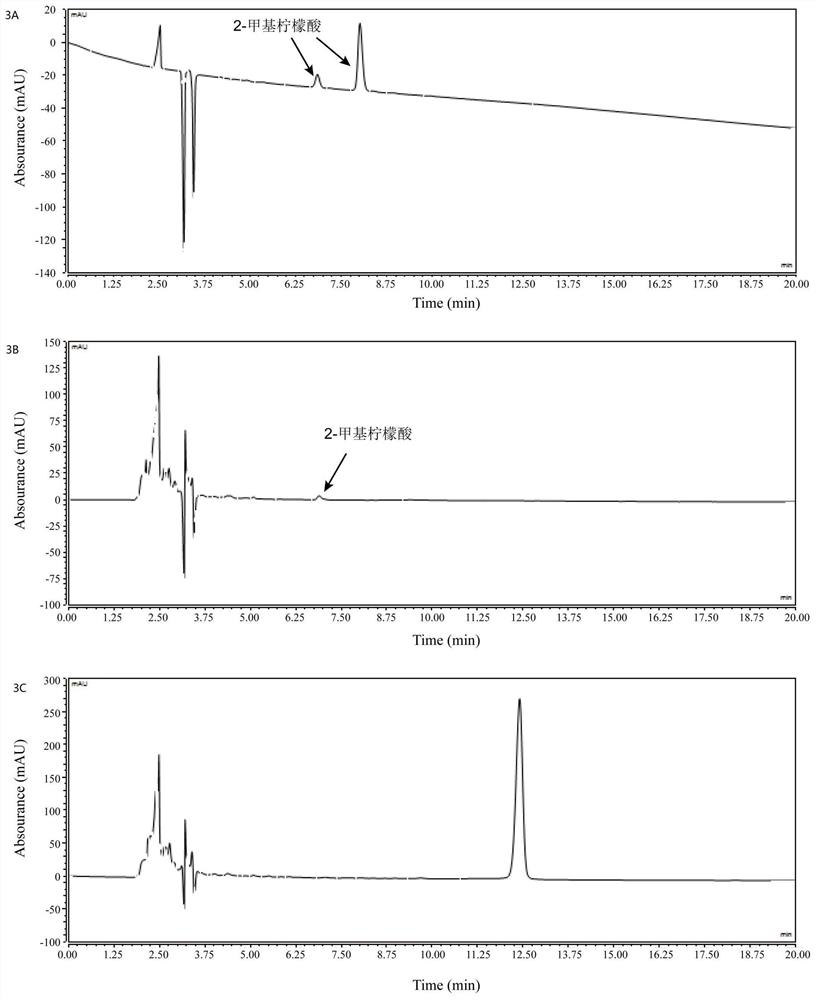A kind of 2-methyl citrate high-yielding genetically engineered bacteria and its construction method
A technology of methyl citric acid and genetically engineered bacteria, applied in the field of genetic engineering, can solve the problems of difficult purification, high price, complex chemical synthesis process, etc., and achieve the effects of reducing production cost and increasing yield
- Summary
- Abstract
- Description
- Claims
- Application Information
AI Technical Summary
Problems solved by technology
Method used
Image
Examples
Embodiment 1
[0033] The construction of engineering bacteria of high yield 2-methylcitric acid of embodiment 1
[0034] 1. Construction of knockout vector pRP1028-prpD-U-D
[0035] Using Bacillus thuringiensis BMB171 as the starting strain, according to the gene sequence of prpD and its upstream and downstream DNA sequences, primers for upstream and downstream homologous fragments were designed respectively, wherein the nucleic acid sequence of prpD is shown in SEQ ID NO:1,
[0036]ATGATTAAAACAAATGAAATTAAGCAAAAAGATGCATTATTAGAAGAGATTACCGATTATGTATTAAATAAAGAGGTTACTAGTGCAGAAGCATTCAGTACAGCTCGTTACGTATTACTTGATACACTTGGATGTGGAATTTTAGCACTGCAATATCCAGAATGTACGAAATTACTAGGACCAGTTGTGCCAGGAACAATCGTGCCAAATGGTACACGTGTACCAGGTACGTCTTATGTACTAGATCCAGTAAAAGGTGCATTTAATATCGGATGTATGATCCGTTGGTTAGACTATAACGATACTTGGCTTGCAGCAGAGTGGGGACATCCATCTGATAACCTAGGCGGAATTTTAGCAGTTGCAGATTATATTAGCCGTGTTCGTATTTCAGAAGGAAAAGAAGCTTTAAAAGTACGTGAAGTATTAGAAATGATGATTAAAGCACATGAAATTCAAGGCGTGCTTGCTTTAGAAAACAGCTTAAACAGAGTTGGTCTTGACCATGTATTATATGT...
Embodiment 2
[0056] Determination of 2-methylcitric acid synthesis time point in embodiment 2 Bacillus thuringiensis
[0057] 1. Transcription fusion vector pHT1K-P prpC -Construction and extraction of lacZ
[0058] The plasmid pHT1K containing lacZ was selected as the transcriptional fusion vector from the plasmid preserved in our laboratory. The plasmid pHT1K-lacZ contains ampicillin (Amp) resistance and erythromycin (Ery) resistance, and its nucleotide sequence is as SEQ ID NO: 11.
[0059] The total DNA of BMB171 was used as the template of the PCR amplification reaction, and the primer P prpC -lacZ-F and primer P prpC -lacZ-R amplified to obtain the prpC promoter fragment. where primer P prpC -lacZ-F and primer P prpC The sequences of -lacZ-R are respectively shown in SEQ ID NO: 8 and SEQ ID NO: 9:
[0060] CCCCCATGGTAACTTTATTAAAAAATGA (SEQ ID NO: 8)
[0061] GGATCCTATTTCCTCCAATCCTAATAG (SEQ ID NO:9)
[0062] The PCR configuration system is: DNA template 1 μL, primer P prpC ...
Embodiment 3
[0072] Example 3 Extraction and content determination of intracellular 2-methylcitric acid in Bacillus thuringiensis
[0073] 1. Extraction method
[0074]The crude product of 2-methylcitric acid was obtained by ultrasonic crushing combined with pre-treatment of organic solvent for impurity removal. The specific steps are: culture BMB171 or ΔprpD strain in GYS medium for 6h or 12h, collect 35mL bacterial liquid, centrifuge at 12,000r / min for 2min, discard supernatant, add 10mL ddH2O to suspend bacterial cells; place in ice bath water, use Ultrasonic cell disruptor (Ningbo Xinzhi Biotechnology Co., Ltd.) was crushed for 30 minutes (ultrasonic power: 250W, ultrasonic work 1.0s, ultrasonic stop 1.5s, so repeated, a total of 30min); then, centrifuge at 12,000rpm for 5min, and collect the supernatant ;Take 3.5mL supernatant, add 31.5mL acetone, shake vigorously on the shaker for 1min, centrifuge at 12,000rpm for 5min, discard the supernatant; put the centrifuge tube with brownish-...
PUM
 Login to View More
Login to View More Abstract
Description
Claims
Application Information
 Login to View More
Login to View More - R&D
- Intellectual Property
- Life Sciences
- Materials
- Tech Scout
- Unparalleled Data Quality
- Higher Quality Content
- 60% Fewer Hallucinations
Browse by: Latest US Patents, China's latest patents, Technical Efficacy Thesaurus, Application Domain, Technology Topic, Popular Technical Reports.
© 2025 PatSnap. All rights reserved.Legal|Privacy policy|Modern Slavery Act Transparency Statement|Sitemap|About US| Contact US: help@patsnap.com



